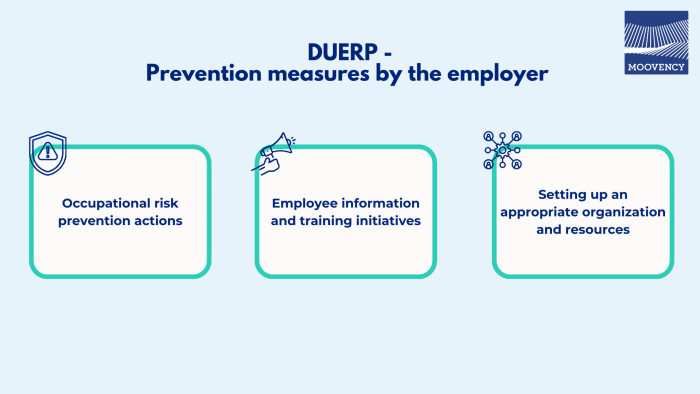HR : Promoting ergonomics in human resources management
The role of a Human Resources Manager in a company is constantly evolving, with a vast and varied scope of missions. Starting from traditional tasks such as recruitment, compensation, skills development, and personnel management, HR directors, managers, and officers also play a crucial role in improving working conditions and employee well-being.
Within the framework of quality of work life and employee well-being, ergonomics can be an important lever in human resources management. The discipline presents decisive challenges for implementing a prevention approach with employees and thus improving company performance. It is therefore essential for the proper functioning of human resources.
But how can directors or human resources managers effectively promote and use it on an organizational level ?
Today, Moovency reveals the various roles that ergonomics can play in human resources management: shall we look together?
Ergonomics & The Single Document for Risk Assessment in the Workplace (DUERP)
According to the Labor Code, every employer has a legal obligation to assess the occupational risks (both physical and psychosocial) to which their employees are exposed and to list them in a document called the Single Document for Risk Assessment in the Workplace (DUERP).
Risk assessment involves an inventory of hazards and an analysis of the identified risks in each work unit of the company or establishment. Following this assessment, the DUERP is used by the employer to establish preventive measures :

In summary, the DUERP summarizes the hazards, associated risks classified by severity, and the protection and prevention measures provided by the company.
LEGAL FOCUS – DUERP
Since March 31, 2022, the DUERP has been subject to new legal rules. Decree No. 2022-395, which came into force on March 31, 2022, specifies the procedures for the preparation, updating, conservation, and availability of the document (Law No. 2021-1018 of August 2, 2021).
- Mandatory consultation of the CSE on the DUERP ;
- Updating of the DUERP: now depends on the size of the company
- Provision of the DUERP to employees and former employees
- Conservation of the DUERP: the law provides for a retention period of not less than 40 years until the obligation of dematerialized deposit is effective (Art. L. 4121-3-1 V-A and R. 4121-4 of the Labor Code).
- Obligation of dematerialized deposit of the DUERP
Ergonomics, and more specifically the use of ergonomic evaluations, enables the identification of risky situations and thus makes the DUERP a real lever for improving the working conditions of employees.
Here are some tips for HR to formalize the DUERP effectively by integrating ergonomics :
- Involve employees in the DUERP design and operation process. Their active participation will enable a more comprehensive identification of risks and hazards, facilitating smooth information flow. Transform the DUERP into a dynamic and living tool by making it accessible and understandable for everyone.
- Establish multidisciplinary working groups : To better understand the risks associated with positions and operations in a work environment, form a multidisciplinary team with key functions (HSE, QHSE, CHSCT, etc.) who, in addition to employees, will provide their expertise on the subject.
- Foster constructive exchange during analysis presentations. Build collective dialogue with employees to raise awareness of identified potential risks and to collectively brainstorm appropriate prevention solutions. This participatory approach enhances everyone’s commitment and accountability in the risk prevention process.
- Place particular importance on internal communication about selected measures. Once prevention measures have been implemented, strengthen communication on the subject to effectively conclude the process and highlight the efforts and interventions of everyone involved in addressing the identified risks. The DUERP is a document that should be available to employees in the company, so communication about it is crucial !
Ergonomics & Employee Return to Work and Job Retention
After a long period of sick leave, some employees may struggle to return to their positions or risk being deemed unfit. Every employee can be affected by job retention, regardless of age, experience, or job role : supporting your employees after long-term sick leave helps reduce turnover, absenteeism costs, productivity loss, and organizational impacts.
Therefore, job retention is a major concern for a company, and the employer/employee representative (HR) is a key contact point to help employees return effectively to their positions and/or find solutions adapted to the job in relation to physical restrictions.
In this scenario, ergonomics plays an important role in analyzing the constraints and resources of a job or work situation and finding compensatory solutions for job retention.
What advice can HR offer to best facilitate return to work and job retention?
- Conduct a job analysis : To anticipate risky situations and limit further sick leave and occupational illnesses, proactively identify the most demanding positions to determine priority actions in your prevention efforts.
- Raise awareness among different internal stakeholders : Training and sensitizing employees are essential for recognizing and preventing risky situations, which can significantly reduce workplace accidents and occupational illnesses.
- Maintain contact with the employee during their sick leave with a liaison meeting : Starting at 30 days of sick leave, you can initiate a liaison meeting to maintain contact with the employee, guide them towards stakeholders involved in return to work and job retention, and inform them of their rights and available programs.
- Direct the employee to the occupational health physician for a pre-return visit : The employee has the option to request a pre-return visit with the occupational health physician to prepare for their return to work and receive assistance in the process. This visit also allows consideration of various situations (fitness for work, job reassignment within the company, workplace adjustments) to anticipate the return to work.
Ergonomics & Employee Training and Awareness
The human resources department plays a key role in fostering a safety culture and implementing prevention measures within an organization. They hold social data of the company (such as absenteeism, turnover), manage sick leave and occupational illnesses, prevent risks, and oversee job and skill management. Therefore, HR can significantly contribute to prevention and risk management within a structure.
Implementing regular training on preventing risky situations allows your employees to become actively involved in their own prevention. Employees themselves are the first affected, and it’s important to raise their awareness of the importance of prevention. For instance, you can set up training sessions on topics such as MSDs and their onset, best professional practices, ergonomic gestures, and postures.
Workshops for raising awareness in real work situations can also be established to make the awareness both engaging and practical, enabling recognition and prevention of risky situations.
Through training and awareness initiatives, the human resources department mobilizes stakeholders in collective prevention efforts and champions workplace health and safety projects.
To conclude
The integration of ergonomics into human resource management is essential to ensure quality of work life and employee well-being within an organization. By adopting a proactive approach, HR managers can not only contribute to reducing workplace accidents and occupational illnesses but also improve productivity and job satisfaction.
By involving employees in the design of the DUERP, promoting job retention after a period of absence, and organizing regular training and awareness programs, HR can create a safer work environment.
In essence, ergonomics extends beyond the physical layout of workstations; it encompasses a holistic approach to health and safety in the workplace, in which human resources play a central role. By fully integrating ergonomics into their practices, HR can contribute to creating an organizational culture focused on risk prevention and employee well-being, which is an asset for the performance and sustainability of the company.
Sources :
CARSAT Bretagne – Accompagner le retour à l’emploi https://www.carsat-bretagne.fr/home/entreprises/vos-obligations-et-demarches/accompagner-le-retour-a-l-emploi.html
Entreprendre Service Public – Qu’est-ce que le DUERP ? https://entreprendre.service-public.fr/vosdroits/F35360
ANCT – Le Responsable RH, acteur incontournable des démarches Santé et Performance https://www.anact.fr/sites/anact/files/le-responsable-rh-acteur_incontournable-des-demarches-sante-performance.pdf
MOODWORK – DRH : Vos obligation en matière de DUERP https://moodwork.com/blog/well-being/drh-vos-obligations-en-matiere-de-duerp/
